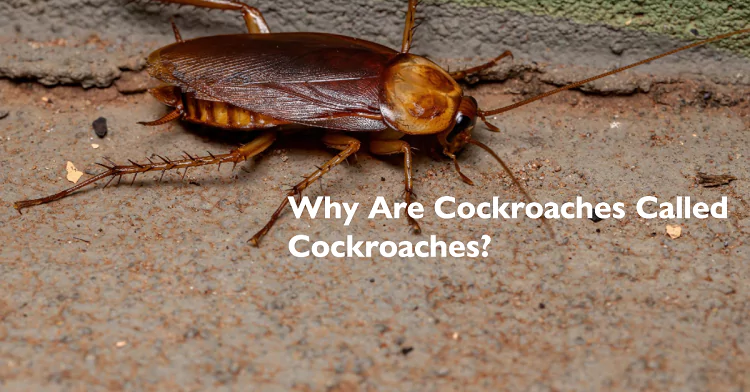Have you ever wondered why those creepy crawlers scuttling around our homes and gardens are called cockroaches? These pesky insects have a reputation for being tough survivors, making them a common household pest worldwide. But where did they get their peculiar name?
The name “cockroach” has a surprisingly ancient origin. It dates back to the early 17th century when English-speaking people started encountering these insects during their explorations and travels. The word “cockroach” comes from two Old English terms: “cock” meaning “to turn” or “twist,” and “roach” referring to a type of beetle.
The moniker fits these creatures well as they possess a distinct ability to twist and turn their bodies with incredible agility, allowing them to fit into tiny crevices and evade predators. Moreover, cockroaches have been around for millions of years, adapting and surviving through various environmental changes.
In this blog post, we’ll delve deeper into the intriguing world of cockroaches, exploring their fascinating characteristics and why they have managed to thrive alongside humans for so long. So, let’s get ready to uncover the secrets of these ancient insects!
Origins of the Name
The term “cockroach” has a long and intriguing history. Its etymology can be traced back to the Spanish word “cucaracha,” which translates to “cockchafer” or “beetle.” The Spanish were one of the first European explorers to encounter these insects during their travels, and they brought the term back to Europe. Over time, “cucaracha” evolved into “cockroach” in English, likely due to the resemblance of the insect’s shape to that of a beetle.
Physical Characteristics
Cockroaches are insects belonging to the order Blattodea. They are characterized by their flattened bodies, long antennae, and wings. Their exoskeleton provides them with a protective shell, which is essential for their survival in various habitats. These hardy insects have evolved to adapt to a wide range of environments, making them highly successful and resilient.
Habitat and Distribution
Cockroaches have a global presence, inhabiting almost every continent on Earth. They are commonly found in warm and humid regions, but they can also thrive in colder climates. These versatile insects are skilled at hiding in cracks and crevices, making it challenging to detect and eradicate them from human environments.
Diet and Feeding Behavior
As omnivores, cockroaches have a diverse diet. They consume both plant matter and various organic substances. Their scavenging nature leads them to search for food primarily during the night, making them nocturnal creatures. This behavior often brings them into contact with human habitats, leading to unwanted interactions.
Reproduction and Life Cycle
The reproductive capabilities of cockroaches are impressive and contribute to their survival. Females lay egg cases, called oothecae, which contain multiple eggs. These egg cases are often hidden in secluded areas, protecting them from potential threats. Once hatched, the nymphs go through several molting stages before reaching adulthood.
Survival Skills
Cockroaches have developed survival skills that have allowed them to thrive for millions of years. They can endure extreme conditions, including radiation exposure and lack of food and water. Their ability to flatten their bodies enables them to squeeze through narrow openings, ensuring easy access to various environments.
Interactions with Humans
While cockroaches play important roles in ecosystems by breaking down organic matter, they can also be pests in human environments. They are known to infest homes, restaurants, and food storage areas, posing health risks. Cockroaches can carry diseases and contaminate food, making their presence undesirable.
Myths and Misconceptions
Over the years, several myths and misconceptions have been associated with cockroaches. One common belief is that they can survive a nuclear apocalypse. While they are indeed resilient, this myth is an exaggeration. Understanding the truth behind such misconceptions helps in developing effective pest control strategies.
Role in Ecosystem
In the natural world, cockroaches serve as important links in the food chain. They are prey for various predators, contributing to the balance of ecosystems. Additionally, they aid in the decomposition of organic matter, recycling nutrients back into the soil.
Pest Control
Controlling cockroach populations can be challenging due to their ability to adapt and reproduce rapidly. Effective pest control involves a combination of preventive measures, sanitation, and targeted extermination methods. Integrated pest management strategies aim to minimize their impact on human environments.
Cultural Significance
Cockroaches have left their mark on human culture, appearing in folklore, mythology, and symbolism across different societies. In some cultures, they are associated with resilience and survival, while in others, they may symbolize impurity or bad luck.
Scientific Studies and Research
Scientists have conducted various studies to understand cockroach behavior and biology better. Some research has focused on their locomotion, communication, and sensory abilities. Additionally, cockroaches have served as valuable subjects for studying neurobiology and robotics.
Unusual Facts
Beyond their negative reputation, cockroaches possess several fascinating and unusual traits. For example, some species exhibit maternal care, protecting and grooming their offspring. Moreover, they can run at impressive speeds and navigate complex mazes with ease.
Conclusion
Cockroaches have earned their name from historical origins linked to the Spanish word “cucaracha.” These hardy insects boast remarkable survival skills and have adapted to thrive in diverse environments. While they play essential roles in ecosystems, their interactions with human habitats can lead to pest-related issues. Understanding these ancient insects better can aid in implementing effective pest control measures and dispelling common myths associated with them.

Mark Thompson, a seasoned pest controller, is renowned for his expertise in keeping homes and businesses free from unwanted intruders. With a passion for environmental sustainability and a deep understanding of pest behavior, Mark has become a trusted authority in the industry.
